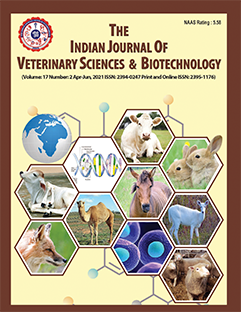Characterization and Toxicological Assessment of Iron and Zinc Nanoparticles in Male Wistar Rats
DOI:
https://doi.org/10.48165/ijvsbt.21.5.6Keywords:
Characterization, Iron deficiency anaemia, Nanoparticles, Rat model, Toxicological assessmentAbstract
Iron deficiency anaemia (IDA) is often studied using rat models to better understand the condition and evaluate treatment options. In this study an in vivo rat model of IDA was developed by inducing dietary iron deficiency anaemia (IDA) by offering iron-deficient diet over a period of 8-weeks to male Wistar rats as evidenced by a significant reduction in haemoglobin levels to below 9 g/dL, thereby providing a robust framework. This study explored the formulation and characterization of iron and zinc nanoparticles (100 nm and 71 nm, respectively). Adult Wistar rats (n=24) were distributed into three equal groups for treatment trial of 56 days. One group kept as control (T1) received double distilled water, while treatment groups received ionic form (T2) of 0.1 M solution each of ferric chloride hexahydrate and zinc sulphate heptahydrate, and nanoparticle forms (T3) of iron (20 mg/d) and zinc (10 mg/d) doses. Acute toxicity in the nanoparticle-treated group T3 led to 100 % mortality within 24 h with severe histopathological alterations in vital organs like liver, kidneys, spleen, heart and testes, while in ionic form T2 group subacute toxicity occurred, which was assessed over 56 days with very mild cellular changes or structures almost towards normal control group. The findings emphasized the need for cautious evaluation of zinc and iron nanoparticles in therapeutic applications.
Downloads
References
Anonymous. (2018). Annual progress report 2017–18. Centre of Advanced Research in Plant Tissue Culture, Anand Agricultural University, Anand, Gujarat, India.
Bhavsar, P. P. (2022). Development of nanofortified functional milk using iron and zinc nanoparticles (Ph.D. thesis). Kamdhenu University, Anand, Gujarat, India.
Chaparro, C. M., & Suchdev, P. S. (2019). Anaemia: Epidemiology, pathophysiology, and etiology in low- and middle-income countries. Annals of the New York Academy of Sciences, 1450(1), 15–31.
Chen, Y. (2023). The relationship between zinc and human health and how to supplement zinc scientifically. Theoretical and Natural Science, 4(1), 1–6.
Dubey, P., Thakur, V., & Chattopadhyay, M. (2020). Role of minerals and trace elements in diabetes and insulin resistance. Nutrients, 12(6), 1–17.
Ijaz, I., Gilani, E., Nazir, A., & Bukhari, A. (2020). Detailed review on chemical, physical and green synthesis, classification, characterizations and applications of nanoparticles. Green Chemistry Letters and Reviews, 13(3), 59–81.
Kulkarni, S., Niharika, S., & Thakur, M. (2020). Sub-acute toxicity assessment of green synthesized hematite nanoparticles (α-Fe2O3NPs) using Wistar rat. Research Journal of Biotechnology, 15(4), 4.
Kumar, S., Arora, D., Dhupar, A., Sharma, V., Sharma, J. K., Sharma, S. K., & Gaur, A. (2020). Structural and optical properties of polycrystalline ZnO nanopowder synthesized by direct precipitation technique. Journal of Nano- and Electronic Physics, 12(4), 4–27.
Le, N. T., Truong, N. X., & Dung, D. T. (2022). Green synthesis of iron nanoparticles using Cleistocalyx operculatus leaves extract and application of iron nanoparticles to treat organic dye Methylene Blue. Vietnam Journal of Catalysis and Adsorption, 11(4), 63–67.
Nahari, M. H., AlAli, A., Asiri, A., Mahnashi, M. H., Shaikh, I. A., Shettar, A. K., & Hoskeri, J. (2022). Green synthesis and characterization of iron nanoparticles synthesized from aqueous leaf extract of Vitex leucoxylon and its biomedical applications. Nanomaterials, 12(14), 2404.
Omar, F. M., Aziz, H. A., & Stoll, S. (2014). Aggregation and disaggregation of ZnO nanoparticles: Influence of pH and adsorption of Suwannee River humic acid. Science of the Total Environment, 468, 195–201.
Ostolska, I., & Wisniewska, M. (2014). Application of the zeta potential measurements to explanation of colloidal Cr2O3 stability mechanism in the presence of the ionic polyamino acids. Colloid and Polymer Science, 292(10), 2453–2464.
Prajapati, B. J. (2024). Toxicological and remedial study of zinc nanoparticles and bulk zinc on seed vigour, microbial activity and performance of wheat (Ph.D. thesis). Anand Agricultural University, Anand, Gujarat, India.
Rehman, N., Jabeen, F., Asad, M., Nijabat, A., Ali, A., Khan, S. U., Luna-Arias, J. P., Mashwani, Z. U. R., Siddiqa, A., Karthikeyan, A., & Ahmad, A. (2024). Exposure to zinc oxide nanoparticles induced reproductive toxicities in male Sprague Dawley rats. Journal of Trace Elements in Medicine and Biology, 83, 127411.
Suva, M. A., & Tirgar, P. R. (2023). Comparative evaluation of antianaemic effect of sucrosomial iron in experimental model of iron deficiency anaemia in Wistar rats. Current Issues in Pharmacy and Medical Sciences, 37(1), 26–32.
Thakur, M. K., Kulkarni, S., Mohanty, N., Kadam, N., & Swain, N. (2019). Standardization and development of rat model with iron deficiency anaemia utilizing commercially available iron-deficient food. Biosciences, Biotechnology Research Asia, 16(1), 71–77.
Tyagi, N., Gupta, P., Khan, Z., Neupane, Y. R., Mangla, B., Mehra, N., & Kohli, K. (2023). Superparamagnetic iron-oxide nanoparticles synthesized via green chemistry for the potential treatment of breast cancer. Molecules, 28(5), 2343.
Yun, J. W., Kim, S. H., You, J. R., Kim, W. H., Jang, J. J., Min, S. K., Kim, H. C., Chung, D. H., Jeong, J., Kang, B. C., & Che, J. H. (2015). Comparative toxicity of silicon dioxide, silver and iron oxide nanoparticles after repeated oral administration to rats. Journal of Applied Toxicology, 35(6), 681–693.
Zaman, M., Ang, S., & Singh, S. (2016). Characterizing nanoparticle size by dynamic light scattering. Journal of the Arkansas Academy of Science, 70(1), 255–259.
Zambri, N. D. S., Taib, N. I., Abdul Latif, F., & Mohamed, Z. (2019). Utilization of neem leaf extract on biosynthesis of iron oxide nanoparticles. Molecules, 24(20), 3803.
Downloads
Published
Issue
Section
License
Copyright (c) 2025 Indian Journal of Veterinary Sciences and Biotechnology

This work is licensed under a Creative Commons Attribution-NonCommercial-NoDerivatives 4.0 International License.




